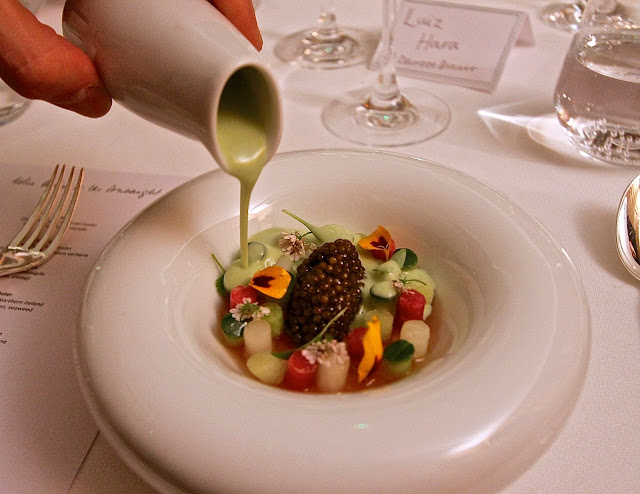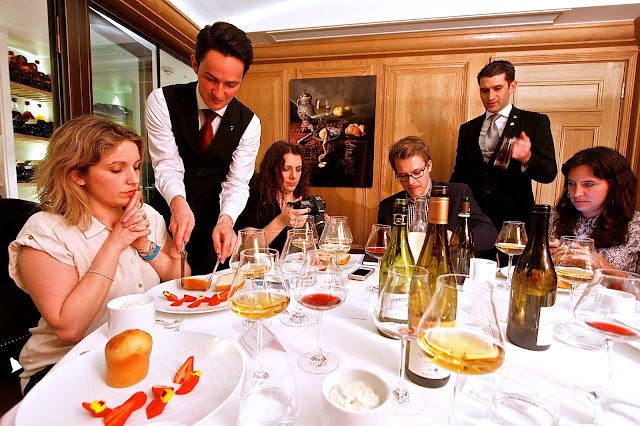Name: HKK (Chinese New Year Menu)
Where: 1 Snowden Street, London, EC2A, http://hkklondon.com/
Cost: The Chinese New Year menu is available from 25th January until 20th February 2016. The food menu costs £88 per person with an option of £48 per person for drinks pairing.
About: One of my favourite Chinese restaurants in London, HKK is one of just a handful of restaurants I visit regularly whenever I crave top quality Chinese food.
February is a great time of the year to visit such restaurants, as most will devise some exquisite menus to celebrate their most important calendar event of the year – the Chinese New Year. With that in mind, I hastened along to HKK for a sneaky peak at their 2016 Year of the Monkey menu and what is on offer until late February.
What We Ate and Drank: We kicked off with the Prosperity Platter which included a very refined version of the traditional prosperity salad. Typically served to start a family New Year meal, all the guests stand and toss the salad high in the air with their chopsticks while saying auspicious things to bring good luck, health and prosperity in the new year. HKK's version combined julienned pumpkin and daikon, crispy salmon skin, green and red seaweed, peanuts, pomegranate seeds and olive oil, all topped with some real gold leaf.
The second element of the platter was the 'fortune wrap' – this was a delectable dried Japanese oyster in Chinese leaf, with a scattering of black moss. The third and final item was a lovely little cube of Welsh organic pork belly, with a thin, crisp layer of fat, grilled and lightly spiced with sea salt, mustard and goji berry.
We opted for the drinks flight at £48 per person to partner each course. The Prosperity Platter was partnered with a glass of Japanese Mio sparkling sake. I love Mio sake and often serve this at my supper club - it made a deliciously refreshing, low-alcohol start to the meal, with delicate stone fruit and brioche on the nose, and an off-dry finish.
The Tai Ji supreme seafood soup was served yin and yang-style, with one side consisting of crab roe and vegetarian shark fin, the other of egg white in broth, with winter bamboo, scampi and scallops served separately in a spoon. To eat, all three components are mixed together. This was warming, with delicate flavours of freshest seafood, and a refreshing crunchy texture from the winter bamboo.
To accompany, we had a glass of Clos la Cariziere Muscadet Sevre et Maines 2014. I'm not normally a huge fan of Muscadet, but this was a fine example, with a nose of green apple, lemon, and some luscious pineapple and tropical flavours on the finish.
The Chinese believe that it brings good luck and happiness in the coming year to eat dumplings just after midnight - shaped like ancient Chinese gold or silver ingots, they are believed to bring prosperity. And who am I to argue, just give me the dumplings, please! HKK's dumpling trilogy included white (deep fried dumpling of chicken and abalone), orange (steamed dumpling was of scallop and Chinese chive) and green morsels (steamed dumpling of Dover sole with Imperial caviar).
Cleverly, the pastry cases were naturally coloured with gai lan juice (for the green dumpling) and carrot juice (for the orange). These were very well made, with finely textured cases and delicate, well flavoured fillings.
We had a 'bitter fortune' cocktail with Tanquery Number 10 gin, Aperol, rhubarb liqueur and fresh grapefruit juice. Deliciously astringent, this was able to cut through the diverse flavours and textures of the dumplings.
Next up was HKK’s wonderful roasted cherry wood Peking duck - the signature dish of the restaurant. The duck is prepared over 2 days, with a complex, multi-stage process that ends with skin as crisp and thin as caramel, with the flesh still utterly succulent. Served with a delicious little salad of micro-herbs and fragrant pea shoots, this was as wonderful as I recall from an earlier visit. If you would like to try this amazing duck over a four-course lunch with a bottle of Champagne thrown in, the restaurant offers a special Peking Duck menu on Saturday lunch times only, reviewed here.
The duck was matched with a glass of Tsarine brut rose Champagne, that had refreshing strawberry and redcurrant notes.
My favourite course of the evening was HKK’s lobster noodles with an XO sauce, dried prawns and scallop, Parma ham, garlic and shallot. It was served with 'longevity noodles', symbolic of a long and healthy life. The lobster was magnificent - a generous serving, tender and with many layers of umami flavours from the dried seafood and XO sauce.
To accompany, we were served a glass of Chablis, Domaine Bernard Moreau et Fils, 2012. Full bodied, and aged in French oak, this was a rich, creamy wine with gentle tropical fruit on the finish. It had more than enough depth of flavour and complexity to match the richly flavoured lobster.
To finish the mains, we were served an outstanding dish of Welsh lamb with Sichuan mala sauce (spiked with toban jan, a fermented soybean chilli sauce) that came with rice and pumpkin cakes, shiso leaves, and romanesco broccoli.
With the lamb, we were served a glass of Ribeira del Duero from Dominio de Atuata, Spain, 2011. Made from Tempranillo grapes, this had intense mint, black cherry and vanilla notes, but was well structured with plenty of tannin to balance the rich sweetness of the fruit.
For our pre-dessert, we had vanilla and mandarin 'Tangyuan dumplings', with osmanthus and orange infusion. The round dumplings, and the bowls in which they are served, are said to represent family unity. With a crisp white chocolate shell and mandarin glaze, surprisingly filled with vanilla ice cream, this was wonderfully refreshing, served with pomegranate, lime caviar, an orange and osmanthus infusion, micro-coriander and a glass of orange and osmanthus iced tea.
To accompany, we had a glass of Diplomatico Reserva 8 year old rum from Venezuela which had plenty of spice and vanilla and made for an unusual but interesting pairing.
Dessert proper was a green apple parfait, with cardamom cake, crispy apple noodle, apple sorbet and puree. This was an inventive, chefy with a surprising mix of textures and apple flavours, not so sweet or heavy as to overwhelm our palate at the end of the meal.
We were served a glass of luscious Samos Grand Cru 2014, Muscat Petit Grain, from the Greek island of Samos with our apple dessert.
To round off, we were brought the 'Tray of Togetherness' - these were a selection of delectable petit four, including grapefruit jelly, lime marshmallow, pandan choux, almond financier, white chocolate and passion fruit truffle, red bean choux, smoked salted caramel and dark chocolate truffle and yuzu jelly. I am not sure we were meant to have them all, we were asked to choose the ones we wanted, and of course I had to try the lot! They were all exquisite, but the salted caramel in particular was the star of the show in my opinion.
Likes: All the dishes were cooked with great skill, and were gorgeously presented. For me, particular highlights were the Peking duck and the lobster dish, but there wasn't a weak dish on the menu.
Dislikes: None
Verdict: For a great way to see in the Year of Monkey in 2016, I can't think of many other places I would rather be than HKK. This special Chinese New Year menu runs only until 20th February 2016, so hurry along if you fancy a fix of brilliantly cooked celebratory lobster, cherry wood roasted Peking duck and a selection of fine wines and Champagne. Highly recommended.





























































